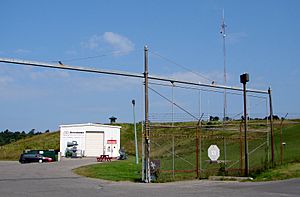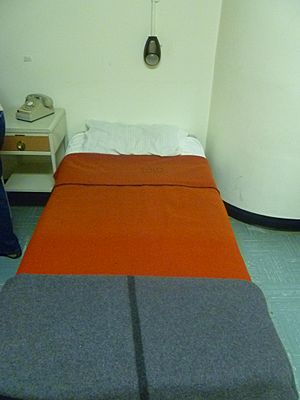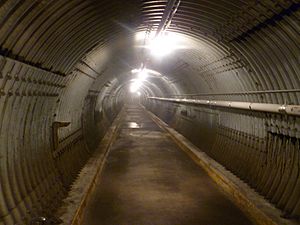CFS Carp facts for kids
Quick facts for kids Canadian Forces Station Carp |
|
|---|---|

Carp Diefenbunker gate and entrance
|
|
| Location | Ottawa, Ontario, Canada |
| Founded | 1962 |
| Founder | Diefenbunker Development Group |
| Built | 1959–1961 |
| Original use | Emergency Government Headquarters |
| Current use | Museum |
| Architect | Foundation Corporation of Canada, L. Col. Ed Churchill |
| Governing body | Diefenbunker, Canada's Cold War Museum |
| Website | Diefenbunker: Canada's Cold War Museum |
| Official name: Diefenbunker / Central Emergency Government Headquarters National Historic Site of Canada | |
| Designated | 1994 |
Canadian Forces Station Carp (also known as CFS Carp or The Diefenbunker) is a former Canadian military base. It is located in the small farming community of Carp in Ottawa, Ontario. This site is about 30 kilometers (18.6 miles) west of downtown Ottawa.
CFS Carp was closed down in 1994. In 1998, it reopened as the Diefenbunker, Canada's Cold War Museum. It was also named a National Historic Site of Canada. You can visit it for tours all year round.
Contents
History of the Diefenbunker
Why Was the Diefenbunker Built?
In 1958, the world was in the middle of the Cold War. This was a time of tension between the United States and its allies (like Canada) and the Soviet Union. People were worried about intercontinental ballistic missiles (ICBMs), which are very long-range missiles.
Because of these fears, Canada's Prime Minister, John Diefenbaker, decided to build special shelters. These shelters were called "Diefenbunkers" by some. There were almost 50 of them across Canada. They were part of a plan called "Continuity of Government." This plan aimed to protect government leaders in case of a nuclear attack.
Building the Carp Diefenbunker
The first location chosen for the main bunker was near Almonte, Ontario. However, there was too much groundwater there. So, an old gravel pit outside Carp was chosen instead. Construction started in 1959 and finished by 1962.
The Carp bunker was the largest of these facilities. It covered over 9,300 square meters (100,000 square feet). This underground building has four floors. It needed 32,000 tonnes of concrete and 5,000 tonnes of steel to build. The bunker was designed to survive a nuclear blast up to 5 megatons from 1.8 kilometers (1.1 miles) away.
It had huge blast doors at the surface. It also had special air filters to keep out radiation. Even though it was built to protect against nuclear attacks, later bombs called "bunker busters" could have damaged it. These newer bombs had special fuses that would explode deep underground.
What Was Inside the Bunker?
The Diefenbunker had underground storage for food, fuel, and fresh water. It could hold 565 people for up to one month without needing supplies from outside.
Inside, there was an emergency broadcast studio for the Canadian Broadcasting Corporation (CBC). There was also a secure vault on the lowest level. This vault was meant to hold the gold reserves of the Bank of Canada.
These facilities were managed by the Royal Canadian Corps of Signals. There were also other smaller radio sites nearby that helped the main bunker communicate.

Diefenbunker, Canada's Cold War Museum
From Military Base to Museum
CFS Carp was closed in 1994. This happened because the threat from ICBMs became much lower.
From 1959 to 1994, the Canadian government owned and ran the site. After it closed, local people became very interested in the bunker. They wanted to see inside. A group of volunteers realized how important this place was for history and tourism. They decided to open it as a museum about the Cold War.
In 1998, the Diefenbunker Development Group bought the site. It officially opened as a museum. Soon after, its name changed to the Diefenbunker, Canada's Cold War Museum. It is now open for public tours all year.
Many parts of the bunker are being restored to look like they did when it was active. These include the Prime Minister's Suite, the Emergency Government Situation Centre, and the CBC Emergency Broadcasting Studio. The vault for the Bank of Canada is also being restored. The other 358 rooms now have exhibits about the Cold War.
How the Museum Grew
When the museum first opened in 1998, only volunteers ran it. About 5,000 visitors came that year, which was a lot for volunteers to handle.
In 1999, the museum hired a curator and some students. The number of visitors doubled to 10,000 people.
The museum kept growing in the 2000s. In 2000, almost 15,000 visitors came. More staff were hired to help keep the museum running. By 2008, about 25,000 people visited each year. In 2012, the museum had 45,280 visitors. In 2017, Canada's 150th birthday, the Diefenbunker welcomed 88,000 visitors! It is still one of Ottawa's most popular tourist spots.
The museum's goal is to help people in Canada and around the world learn about the Cold War. They do this by keeping the Diefenbunker as a national historic site and running the museum.
Collections and Research at the Diefenbunker
The Diefenbunker has many items from the Cold War. It also has an archive and a library. These are available for researchers who want to learn more. The general public can see many of these items in the museum's exhibits.
How the Museum is Funded
The Diefenbunker: Canada's Cold War Museum is a non-profit organization. This means it does not aim to make money. Most of its money (about 75%) comes from ticket sales. The museum also applies for grants from different levels of government. It also relies on donations and support from the community.
Other Services at the Diefenbunker
Besides public tours, the Diefenbunker offers other services. You can rent space in the museum for events or for storage. The old bunker has also been used as a movie set several times.
Images for kids




